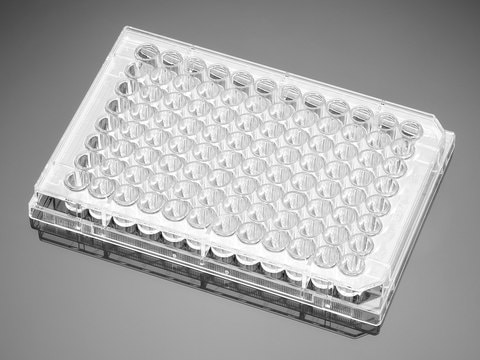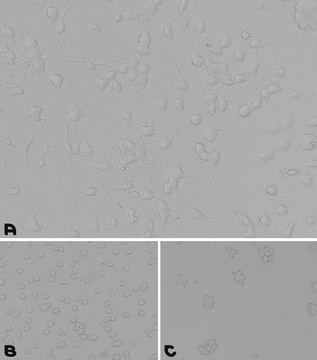LPLO001
Laminin/Poly-L-Ornithine Coating Solution
0.2 μm filtered, BioReagent, suitable for cell culture, Ready-to-use mixture
Sinonimo/i:
Attachment Factors, Coating Mix, Laminin, PLO, Poly-L-Ornithine
Autenticatiper visualizzare i prezzi riservati alla tua organizzazione & contrattuali
About This Item
Codice UNSPSC:
12352202
NACRES:
NA.25
Prodotti consigliati
Livello qualitativo
Sterilità
0.2 μm filtered
Nome Commerciale
BioReagent
Forma fisica
liquid
Confezionamento
pack of 100 mL
tecniche
cell culture | mammalian: suitable
Condizioni di spedizione
wet ice
Temperatura di conservazione
2-8°C
Descrizione generale
Laminin/Poly-L-Ornithine Coating Solution is a ready-to-use attachment factors mix solution, prepared in phosphate-buffered saline and is 0.2µm filtered. It is used to coat cell culture flasks, dishes, and multi-well plates and used to promote the attachment, spreading and proliferation of variety of cell types that require ECM-coated surface for adhesion and 2D cell-culture growth. The combination of Poly-L-Ornithine and Laminin is often used for attachment and promotion of many types of neuronal and neural stem cell cultures. It is suitable for culturing many different types of Peripheral Nervous System (PNS) and Central Nervous System (CNS) networks and is useful for promoting neural cell attachment and differentiation.
Applicazioni
Laminin/Poly-L-Ornithine Coating Solution can be used in:
- Attachment and spreading of a variety of cell types
- Enhancement of neuronal cell attachment to plastic and glass
- Support of neurite outgrowth
- Suitable for use with serum-free or reduced -serum cultures
Azioni biochim/fisiol
Laminin proteins are integral components of structural scaffolding in animal tissues. Laminin has active domains for collagen binding, cell adhesion, heparin binding, and neurite outgrowth fragment. Laminin supports growth and differentiation of many cell types including epithelial, endothelial, neural, muscle and liver cells. Poly-L-Ornithine hydrobromide is a nonspecific attachment factor for cells, useful in promoting cell adhesion to solid substrates by enhancing electrostatic interaction between negatively charged ions of the cell membrane and the culture surface. After absorption to the culture surface, poly-L-Ornithine increases the number of positively charged cell binding sites
Componenti
Laminin is a large basement membrane glycoprotein and composed of three different polypeptide chains, termed α, β and γ. The cohesion between these chains is the result of many inter and intrachain disulfide bonds. Together, they cause the molecule to look like a crucifix.
Poly-L-Ornithine hydrobromide molecular weight is >100,000 Da, a positively charged amino acid polymer.
Poly-L-Ornithine hydrobromide molecular weight is >100,000 Da, a positively charged amino acid polymer.
Nota sulla preparazione
LPLO001 is a ready to use mixture composed of Laminin and Poly-L-Ornithine. It is filtered using 0.2µm filter. Gently mix the Laminin/Poly-L-Ornithine Coating Solution a few times to form a homogenous solution before use. For use as a coating solution, cover the entire culture surface area, approximately 0.2-0.25 mL/cm2. Incubate at room temperature for 2-3 hours and carefully aspirate the solution and wash 3 times with sterile PBS before plating cells. The coated tissue culture vessels can be used immediately or stored at 4 °C for up to one week filled with PBS and wrapped in parafilm. Remove PBS only when ready to plate the cells. Do not let the coated plates dry completely.
Codice della classe di stoccaggio
12 - Non Combustible Liquids
Classe di pericolosità dell'acqua (WGK)
WGK 1
Certificati d'analisi (COA)
Cerca il Certificati d'analisi (COA) digitando il numero di lotto/batch corrispondente. I numeri di lotto o di batch sono stampati sull'etichetta dei prodotti dopo la parola ‘Lotto’ o ‘Batch’.
Possiedi già questo prodotto?
I documenti relativi ai prodotti acquistati recentemente sono disponibili nell’Archivio dei documenti.
Il team dei nostri ricercatori vanta grande esperienza in tutte le aree della ricerca quali Life Science, scienza dei materiali, sintesi chimica, cromatografia, discipline analitiche, ecc..
Contatta l'Assistenza Tecnica.







